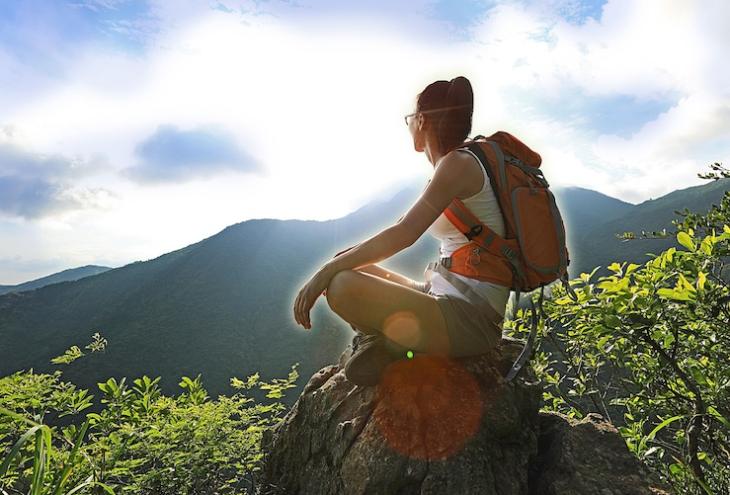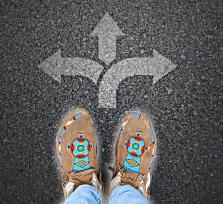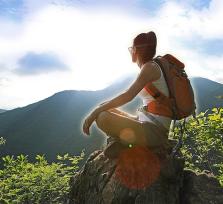Have you ever experienced a churning stomach before giving a presentation, or gotten goosebumps upon hearing a beautiful singing voice? These physiological reactions are caused when the brain releases a chemical — cortisol in times of stress or oxytocin in times of pleasure — in response to whatever emotional event you’re experiencing. The response also demonstrates how closely our mental and physical health are linked. One can have a direct impact on the other, which can affect your overall health and wellbeing. It's known as the mind-body connection.
The most common example of how closely the mind and body work together is our fight-or-flight response. When faced with perceived threats, our mind signals the body to prepare. Typically, you notice an increased heart rate, faster breathing, and a surge of adrenaline. In short, the mind is commanding some sort of physical reaction. But the mind-body connection works both ways. Just as our mind can influence our body, the state of our body can affect our mental health. Regular physical exercise does more than just build and strengthen our muscles — it also helps reduce symptoms of depression and anxiety. Bolstering the connection between the body and mind may benefit all areas of life. It can help reduce stress, promote better sleep, and help to better regulate your emotions. Here are some ways to strengthen the mind-body connection.
Be Mindful
Whether it’s five minutes or a full hour, taking the time to be still can impact your day in a big way. Mindfulness helps you become more aware of your thoughts and feelings and makes it easier to manage your busy daily responsibilities. Start by finding a quiet spot — your bedroom, living room, car, or even the shower — where you can be alone to concentrate on your own thoughts and feelings. (If you prefer to move, take a quiet walk in nature.) Once in place, focus on your breath. Breathing mindfully can calm the nervous system and reduce stress. While in this quiet moment, consider taking time to write down something for which you’re grateful. Shifting away from worries and wants and focusing on gratitude allows you to hone in on the positive, which brings a sense of comfort.
Breathe
When we get anxious or upset, often we’re told, “Breathe.” That’s because breathing patterns help connect our mind and body. Shallow, chest-based breathing can prompt the body’s stress response, while deep breathing triggers a relaxation response. Studies have proven that controlled breathwork helps with emotional regulation, improved concentration, and enhanced physical stamina. If you want to try it for yourself, check out this three-minute breathing exercise that could help when you feel stressed or overwhelmed.
Visualize
Visualization exercises help to calm your nervous system and clear your mind. By picturing a peaceful place or a loving person, the body can experience a relaxing response. The best way to practice visualization is to first find a quiet spot where you won’t be disturbed and settle into a comfortable position. Next, close your eyes and take a few deep breaths, feeling your body relax with each exhale. Then, imagine a place where you feel completely safe and relaxed. Perhaps it’s a place you've visited, like a beach or a special home, or it could be a location you create in your mind, like a cozy cabin in the woods. Picture every detail, including all you see, hear, smell, taste, and feel. Breathe deeply while you imagine this place. As you visualize, feel the safety, peace, and relaxation surrounding you. Be in the moment in that place for as long as you want. When you’re ready, slowly return to your physical surroundings by wiggling your fingers and toes, taking some deep breaths, and gently opening your eyes. Your mind and body will likely feel less tense. Return to your safe place whenever you need peace.
Move Your Body
It may seem counter-intuitive, but physical activity often calms the mind and reduces anxiety thanks to the release of natural mood-boosting chemicals. Choosing to be mentally present during these activities, whether it’s jogging, hiking, dancing, or some other movement, can help strengthen the mind-body connection. Activities like yoga and tai chi purposefully target the relationship, but any type of regular physical activity can also help boost the association.
Remember, your mind and body work in concert with each other, so do your best to implement habits that nourish both. Set aside quiet time for mindful reflection and gratitude. Try to recognize your breathing patterns and learn breathing exercises that help you reset in stressful situations. Visualize a safe or pleasant place that you can “go” and restore your inner peace and know you can call on that vision at any time. And keep moving — it’s a win-win when you can feed your muscles and your mind at the same time.
AISES FACES
Brittany Anderson, M.Ed., Fond du Lac Band of Lake Superior Chippewa
Research & Career Support Senior Program Officer
Aaniin! Mii wa’aw Britttany. Aajijaak inow odoomen a’aw. Nahgahchiwanong onjibaa miinawaa dash widi Gakaabikaang. Mii sa geget ominwendaan naadamawaad inow gidinawemaaganinaana.
Hi I’m Brittany, I’m crane clan from the bottom of the big lake up there in Minnesota. I really enjoy helping out all of our relatives.
AISES has been a major part of my journey — personally, professionally, and academically — since 2010. Despite the titles that may have accompanied that path, my role has stayed the same: to connect, empower, and support others in their pursuit of mino-bimidiziwaan (the good life) by acknowledging we are all scientists.
The Lighting the Pathway to Faculty Careers for Natives in STEM (LTP) is one of the AISES cornerstone programs. Funded from 2014–2024, the program was designed to increase representation in Native STEM Faculty. Guided by the ultimate STEM academic auntie, Dr. Mary Jo Ondrechen (Mohawk), we have come together to support the placement of nearly 30 faculty members through professional development workshops, networking opportunities, mentorship, and connections to AISES resources. More than half the participants are either pursuing or have completed a professional or doctoral degree, and even those who have “stopped out” or chosen other paths have maintained a connection to STEM in their professional career.
While the LTP participants received a full suite of wholistic programming, we also measured the effectiveness of mentorship on STEM student success through another program called Gifts of Knowledge. While both projects have ended on paper, the lessons we’ve learned and the need for student support are still there, and only increasing.
As a long-standing relative in the AISES family, my goal has been to help others recognize what is carried in our knowledge bundles, both as an individual and as a collective. Dabasendizowin (I think lowly of myself) guides me in this work. My dictionary-led brain reads this as “having low self-esteem,” but my embodied Ojibwe spirit knows that this word, this concept is a recognition that I cannot live my life without you. As explained by author James Vukelich Kaagegaabaw (Turtle Mountain Band of Ojibwe).
“We say that ‘I am all of my relatives’ — all the medicines, animals, fish, trees are giving me life. All of my relatives are me, and I am all of my relatives, and we take care of each other. Within this is the recognition that everything that happens will affect you and affect me. It is a very transformative way of looking at the world.”
I’ve been fortunate to be guided by Anishinaabe academic aunties and uncles, like LeAnne Betasamosake Simpson, Lawrence Gross, Brenda Child, and Minogizhigookwe Kathy Absolon to draw upon my own understanding of Indigenous wholistic theory.
Mino-bimidiziwaan for students
Indigenous wholistic theory teaches that wellness and learning are interconnected across the four aspects of being: mental, emotional, physical, and spiritual. It also reminds us of our relationships to self, family, community, nation, society, and creation. As Indigenous STEM students, caring for your whole self is not separate from your academic or career journey—it’s essential to it. Mindfulness and wellness practices support balance and awareness in all areas of life, helping you remain rooted in your values, culture, and responsibilities. Whether you’re doing research, studying, or working in a lab, these practices strengthen your ability to walk in a good way, honoring the knowledge you carry and the relationships you are part of.
Invited Practices
We welcome you to join us at National Conference! Our kumu, Dr. Lelemia Irvine brings in Pasifika practices of ‘awa and talanoa. The ‘awa ceremony, similar to smudging, reminds us of our intimate connection to the land, the water, each other and ourselves. Talanoa, or talking story, creates space for collective understanding and collaborative problem solving through reciprocal connection.
Muckleshoot Meditation
The Muckleshoot Meditation is a guided visualization practice shared our by Muckleshoot relatives that supports grounding, healing, and connection to land and spirit. Rooted in Coast Salish teachings, this meditation invites you to visualize yourself surrounded by the natural world—trees, water, mountains, and ancestors—while drawing strength and balance from these relationships.
Four Sacred Breaths
The Four Sacred Breaths is a mindful breathing practice rooted in Indigenous teachings that honor the interconnectedness of mind, body, spirit, and emotion. This practice uses four intentional breaths to help restore balance, presence, and connection to self and creation. It can be used for personal reflection or in groups to promote clarity, wellness and relational accountability. First, find a comfortable seated or standing position.
Place your feet on the ground, sit upright but relaxed, and gently close your eyes if you feel comfortable.
1. Take the First Breath – for the Mind
Inhale slowly through your nose.
Bring your attention to your thoughts. Allow them to settle.
Exhale gently through your mouth.
Let go of distractions, invite focus and clarity.
2. Take the Second Breath – for the Heart
Inhale slowly through your nose.
Tune into your emotions. What are you carrying today?
Exhale gently through your mouth.
Release any heaviness, make space for compassion.
3. Take the Third Breath – for the Body
Inhale slowly through your nose.
Feel the strength of your body—how it carries you.
Exhale gently through your mouth.
Let go of tension, feel yourself grounded.
4. Take the Fourth Breath – for the Spirit
Inhale slowly through your nose.
Connect to your spirit, ancestors, or sense of purpose.
Exhale gently through your mouth.
Offer gratitude. Feel your spirit lifted.
“If we know who we are, that all life is connected through spirit, and if we learn how to live good lives, then by extension we will act responsibly toward the creation of harmonious and sustainable (healthy) relationships in this world,” (Marsden, 2006).














